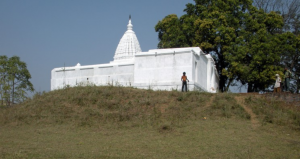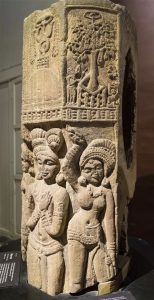OB03174 Periyakaḍu-vihāra Inscribed Rock of circa 6th century
IN03218 Periyakaḍu-vihāra Rock Inscription of circa 6th century
This inscription was discovered by Senarath Paranavitana in 1931 at the site of an ancient monastery, now called Periyakaḍu-vihāra, near Nälava in the Ihala Visidekē Kōrale of the Hiriyāla Hatpattu, Kuruṇǟgala District. It consists of four lines engraved on a rock and can be dated on palaeographic grounds to the last decades of the fifth or the first half of the sixth century. The epigraph records that an individual named Naga, residing at Taḷahaya, settled a debt that he had incurred and caused the cessation of his slavery in the royal monastery of Ekadora, the latter being the ancient name for Periyakaḍu-vihāra. It is well known that, in ancient Sri Lanka, as in India, one particular class of slave was the iṇa-dāsa – a person who had submitted himself to slavery on account of a debt that he had incurred. In such instances, the payment of the debt, either in money or in services rendered, would automatically result in the cessation of the slavery caused by the debt.
IN03198 Habässa Rock Inscription
This inscription is engraved on the wall of a cave at Habässa, the site of an ancient monastery in the forest on the right bank of the Kum̆bukkan Oya, about six miles south-east of the village called Okkampiṭiya in the Buttala Kōraḷē of the Ūva Province. At this site are two long and narrow hummocks of gneiss rock running north-west to south-east. Both have steep overhanging sides, forming a number of caves with drip-ledges. The cave containing the present inscription is one of three caves situated at the southern extremity of the southern range of rock.
The inscription can be dated on the basis of the script and language to the second century A.D. It records the grant of an irrigation channel and three fields to the ancient monastery of Ulibikala-Naka-maha-vihara by the uparāja Naka (Nāga), grandson of King Vahaba (Vasabha) and son of King Utara (Uttara). No king named Uttara is mentioned in the chronicles of Sri Lanka, hence this inscription is of great historical importance as a record of his existence. As his son, Nāga, is described here as a grandson of King Vasabha (r. 66–110 A.D.), it is clear that Uttara was either a son or a son-in-law of the latter – probably a son, since royal genealogies from this period tend to trace the descent directly on the paternal side. The Mahāvaṁsa and the other chronicles mention only one son of Vasabha, namely Vaṁkanāsika Tissa (Tissa the Crooked-Nosed), who succeeded him as king. ‘Uttara’ may, therefore, have been another name of Tissa but it is equally possible that certain historical facts were omitted from the chronicles and that Vasabha did, in fact, have another son who became king.
The present inscription was probably engraved during the reign of Tissa’s son and successor, Gajabāhu I. However, it is noteworthy that the donor of this inscription – an individual called Nāga, who is described here as holding the subordinate rank and office of uparāja – did not deem it necessary to mention the paramount sovereign of the day. In later medieval periods, the title uparāja was generally used by the heir-apparent and the same may be the case here. This conjecture finds support in the chronicles, which record that Gajabāhu’s successor was Mahallaka Nāga (‘Old’ Nāga), indicating that Tissa did have an heir called Nāga.
Inscription (INNAG0010) mentioning Mucalinda on stupa railing pillar (OBNAG0009) from Pauni

Pauni (पौनि) stūpa railing pillar (OBNAG0009) with inscription (INNAG0010) mentioning the nāga Mucalinda
Pauni (पौनि), stūpa railing pillar (OBNAG0008) with figures, architectural elements and an inscription (INNAG0008)

Pauni (पौनि Bhandārā district) Maharashtra. Site of stūpa with modern temple.

Railing pillar (OBNAG0008) from the stūpa, carved with figures, architectural elements and a donative inscription of Nāga.